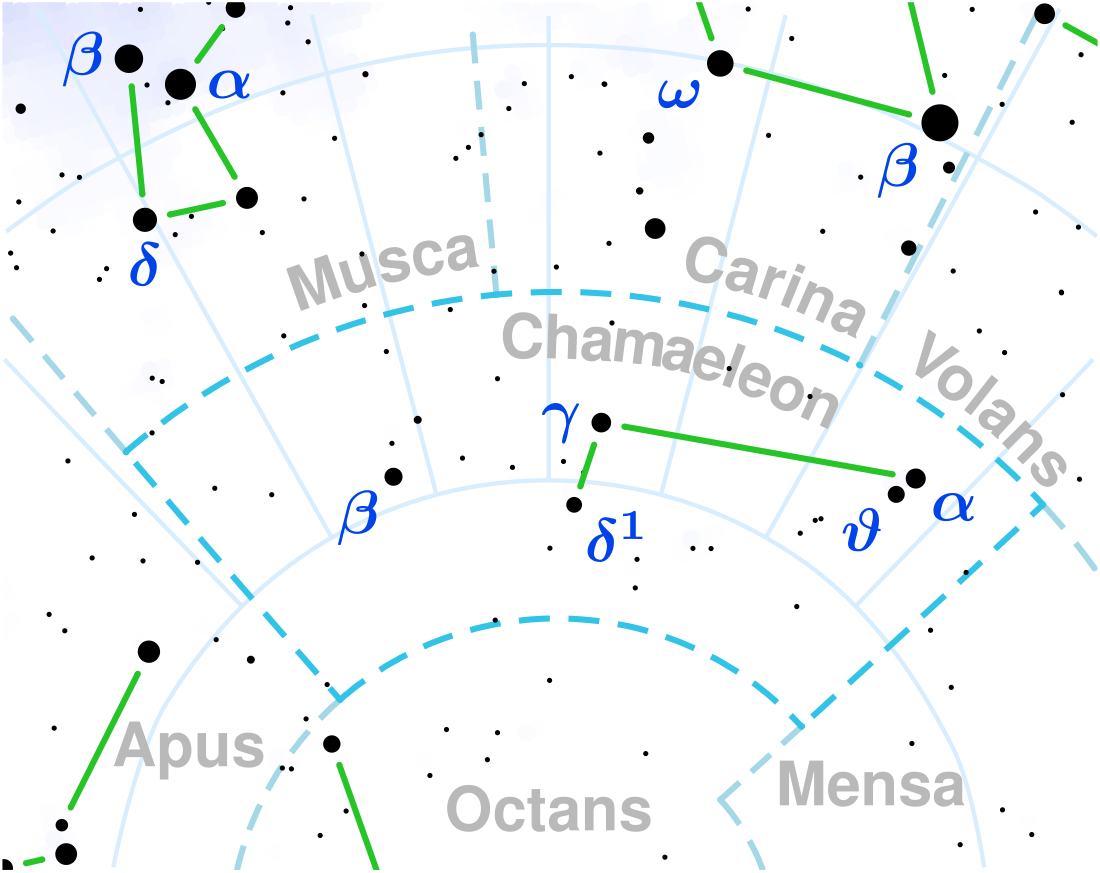Epsilon Chamaeleontis
Star in the constellation Chamaeleon From Wikipedia, the free encyclopedia
Epsilon Chamaeleontis, Latinized from ε Chamaeleontis, is a triple star located in the southern circumpolar constellation Chamaeleon. The primary and secondary have apparent magnitudes of 5.33 and 6.02, making them visible to the naked eye. Hipparcos parallax measurements place the system at a distance of 360 light years[6] and is currently receding with a heliocentric radial velocity of 13 km/s.[5]
| Observation data Epoch J2000.0 Equinox J2000.0 (ICRS) | |
|---|---|
| Constellation | Chamaeleon |
| A | |
| Right ascension | 11h 59m 37.58212s[1] |
| Declination | −78° 13′ 18.5493″[1] |
| Apparent magnitude (V) | 5.33±0.01[1] |
| B | |
| Right ascension | 11h 59m 37.51979s[1] |
| Declination | −78° 13′ 18.9305″[1] |
| Apparent magnitude (V) | 6.02±0.01[1] |
| Characteristics | |
| A | |
| Spectral type | B9 Vn:[2] |
| U−B color index | −0.16[3] |
| B−V color index | −0.06[3] |
| B | |
| Spectral type | A[4] |
| B−V color index | −0.05[1] |
| Astrometry | |
| Radial velocity (Rv) | +13±3.7[5] km/s |
| Proper motion (μ) | RA: −40.34 mas/yr[6] Dec.: −8.30 mas/yr[6] |
| Parallax (π) | 9.02±0.36 mas[6] |
| Distance | 360 ± 10 ly (111 ± 4 pc) |
| Absolute magnitude (MV) | −0.34[7] |
| Details | |
| ε Cha Aa | |
| Mass | 2.87[8] M☉ |
| Radius | 2.3[9] R☉ |
| Luminosity (bolometric) | 99.7[8] L☉ |
| Temperature | 10,617±49[10] K |
| Rotational velocity (v sin i) | 265[11] km/s |
| Age | 2.8 Myr |
| Other designations | |
| ε Cha, 37 G. Chamaeleontis[12], CPD−77° 772, GC 16402, HD 104174, HIP 58484, HR 4583, SAO 256894, CCDM J11596-7813AB, WDS J11596-7813AB[13] | |
| Database references | |
| SIMBAD | data |
The primary has a stellar classification of B9 Vn:,[2] indicating that it is a B-type main-sequence star with broad/nebulous absorption lines due to rapid rotation. However, there is uncertainty behind the suffix.[2] It has 2.9 times the mass of the Sun[8] and 2.3 times its solar radius.[9] It radiates a bolometric luminosity 100 times that of the Sun[8] from its photosphere at an effective temperature of 10,617 K,[10] giving it a bluish-white hue. It is a relatively young star with an age of only 3 million years. Like many hot stars it spins rapidly, having a projected rotational velocity of 265 km/s.[11] Epsilon Chamaeleontis B or HJ 4486B is also a dwarf star of undetermined 'A' spectral type with an effective temperature of about 9600 Kelvin, being based on the lesser apparent visual magnitude of +6.1, and is about 3.0 solar masses.[citation needed]
The binary nature of this system was first observed during February 1836 when Sir John Herschel found it as the close double star, HJ 4486AB.[14] Observations throughout the 20th Century have been slowly reducing, whose latest separation is 0.364 arcsec in position angle 211°, as determined on date 1997.0905 using CCD speckle interferometry by E.P. Horch et al. (1997).[15] It is a likely binary system, though no formal orbit has yet been determined.[4]
Both stars are members of Scorpius-Centaurus Association or the smaller portion known as the Lower Centaurus Crux subgroup. The double star forms the nucleus of the very young Epsilon Chamaeleontis stellar group, which comprises at least 36 stars.[16] The nebulosity and star formation occurring in this region is currently a very important line of study in the southern hemisphere, whose proximity to the Sun is yielding new astrophysical information. Several papers have been published in the last few years on Lower Centaurus Crux subgroup of stars in the far southern constellations of Musca, Chamaeleon and Octans holding the south celestial pole.[17]
References
Further reading
External links
Wikiwand - on
Seamless Wikipedia browsing. On steroids.

